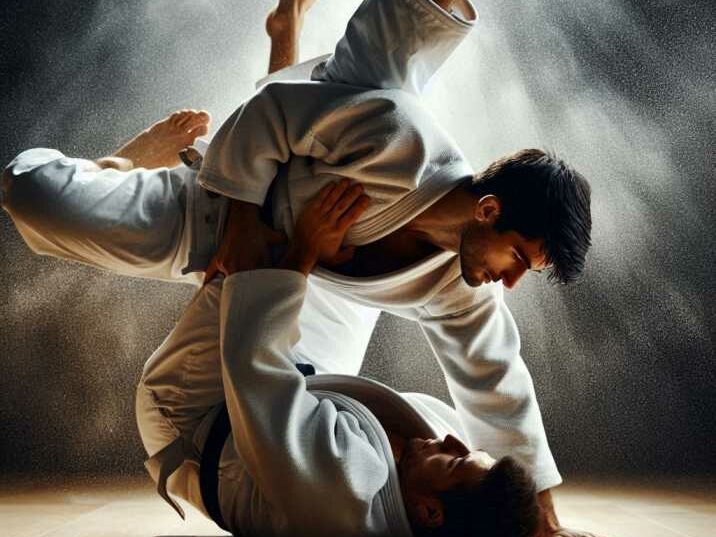Judo is a fascinating martial art that combines physical prowess, mental discipline, and strategic thinking. One of the most intriguing techniques within judo is the sacrifice throw. This technique, which involves intentionally putting oneself in a disadvantageous position to gain an upper hand, requires both skill and practice to execute flawlessly. In this blog post, we will explore the world of judo sacrifice throws, providing insights, practical tips, and examples that cater to both beginners and seasoned practitioners.

What Are Judo Sacrifice Throws?
Table of Contents
Defining Sacrifice Throws
In judo, a sacrifice throw, known as “sutemi-waza,” is a technique where the practitioner (tori) uses their body weight and momentum to throw their opponent (uke) while appearing to sacrifice their balance. This tactic is effective in catching the opponent off guard and using their own force against them.
The Importance of Judo Sacrifice Throws
Judo sacrifice throws are crucial as they allow judokas to turn defensive situations into offensive opportunities. These throws add an element of surprise and can be game-changers in competitive matches.
Key Benefits of Mastering Judo Sacrifice Throws
Versatility:
Sacrifice throws are highly versatile techniques that can be effective in a wide range of scenarios and against various types of opponents. Whether you are up against someone more powerful, agile, or technically proficient, sacrifice throws offer a strategic option to counteract and surprise your opponent. Their adaptability makes them essential tools in a judoka’s arsenal, providing numerous opportunities to turn the tide of a match.
Leverage:
One of the core principles of judo is using an opponent’s force and momentum against them. Sacrifice throws exemplify this principle perfectly. By intentionally falling or rolling, you can harness the opponent’s movement, redirecting their energy to execute a powerful throw. This ability to leverage the opponent’s force allows you to overcome physical disadvantages and gain the upper hand.
Strategic Advantage:
Sacrifice throws are particularly effective at turning seemingly disadvantageous positions into favorable ones. When an opponent believes they have you off-balance or in a vulnerable state, executing a well-timed sacrifice throw can catch them off guard. This element of surprise can disrupt their strategy, giving you a strategic advantage in both competitive and self-defense situations.
Common Sacrifice Throws in Judo
Tomoe-Nage (Circle Throw)
One of the most iconic sacrifice throws in judo, Tomoe-Nage involves the practitioner (tori) intentionally falling onto their back and using their legs to propel the opponent (uke) over their head in a circular motion. This throw is visually striking and highly effective when executed correctly. It utilizes the principle of leverage and momentum to unbalance and throw the opponent.
Sumi-Gaeshi (Corner Reversal)
Sumi-Gaeshi is a backward-rolling throw where tori hooks uke’s leg and rolls backward, flipping uke over their head. This technique is useful when the opponent is pushing forward aggressively, as it uses their momentum against them. By dropping to the ground and rolling backward, tori can leverage their leg to execute a powerful and unexpected throw.

Hikikomi-Gaeshi (Pulling-in Reversal)
Hikikomi-Gaeshi involves tori pulling uke forward while dropping to the ground and then using a leg hook to flip uke over their head. This throw is effective when uke is resisting or trying to retreat. By pulling uke off-balance and then rolling back, tori can use their leg to complete the throw, taking advantage of uke’s forward movement.
How to Perform a Tomoe-Nage
Step-by-Step Guide
- Grip: Secure a firm grip on uke’s lapel and sleeve. This provides control over uke’s upper body and ensures you can guide their movement.
- Position: Drop your body backward and bring your foot to uke’s abdomen. Your foot should be placed firmly to provide the necessary leverage for the throw.
- Execution: Use your leg to lift uke while pulling their sleeve and lapel, flipping them over your head in a smooth, circular motion. Ensure that the movement is fluid to maintain control and balance.
Common Mistakes to Avoid
- Improper Grip: Ensure a strong and secure grip to control the throw. A weak grip can result in loss of control and ineffective execution.
- Weak Leg Push: Use the leg effectively to propel uke. The push should be strong enough to lift uke off the ground.
- Timing: Execute the throw at the right moment to maintain balance and control. Proper timing ensures that uke’s momentum is used to complete the throw.
Practice Drills
- Partner Drills: Practice with a partner to get a feel for the correct timing and grip. Focus on smooth execution and coordination.
- Solo Drills: Use resistance bands or dummy throws to perfect the leg push and timing. These drills help build the necessary muscle memory and strength.
Mastering the Sumi-Gaeshi
Step-by-Step Guide
- Grip: Secure a grip on uke’s lapel and sleeve or belt. This allows you to control uke’s movement and position.
- Position: Drop to your side while hooking uke’s leg with your own. The hook should be firm to provide leverage for the throw.
- Execution: Roll backward while lifting uke over your shoulder, using your leg to flip them. The rolling motion should be smooth to ensure effective execution.
Common Mistakes to Avoid
- Poor Leg Hook: Ensure your leg hooks uke’s leg properly to leverage the throw. A weak hook can result in an ineffective throw.
- Inaccurate Rolling: Roll backward smoothly to execute the throw. Jerky movements can disrupt the throw and reduce its effectiveness.
- Balance Control: Maintain balance throughout the throw to avoid being countered. Proper balance ensures that you remain in control during and after the throw.
Practice Drills
- Partner Drills: Practice with a partner, focusing on the leg hook and rolling motion. This helps refine your technique and timing.
- Solo Drills: Use a judo dummy or resistance bands to simulate the throw and perfect the technique. These drills help build strength and coordination.
Executing Hikikomi-Gaeshi
Step-by-Step Guide
- Grip: Secure a grip on uke’s lapel and sleeve. This provides control over uke’s upper body.
- Position: Pull uke forward while dropping to your back. The pull should be strong enough to off-balance uke.
- Execution: Hook uke’s leg and roll backward, using your leg to flip them over your head. The leg hook should be firm to ensure effective execution.
Common Mistakes to Avoid
- Weak Pull: Ensure a strong pull to off-balance uke. A weak pull can result in an ineffective throw.
- Improper Leg Hook: Hook uke’s leg securely to leverage the throw. A weak hook can disrupt the throw.
- Timing: Execute the throw swiftly to maintain control and balance. Proper timing ensures effective use of momentum.
Practice Drills
- Partner Drills: Practice with a partner, focusing on the pull and leg hook. This helps refine your technique and coordination.
- Solo Drills: Use resistance bands or dummy throws to simulate the throw and improve technique. These drills help build strength and muscle memory.
Tips for Practicing Judo Sacrifice Throws
Safety First
Always practice judo sacrifice throws under the supervision of a qualified instructor to ensure safety and proper technique. This helps prevent injuries and ensures that you are learning the techniques correctly.
Consistent Practice
Regular practice is essential to master sacrifice throws. Dedicate time to drills and partner practice to improve your skills. Consistent practice helps build muscle memory and refine technique.
Analyze and Adapt
Study matches and practice sessions to identify areas for improvement. Adapt your techniques based on feedback and observations. Continuous learning and adaptation are key to mastering judo techniques.
The Role of Competitive Judo Sacrifice Throws
Strategic Advantage
Sacrifice throws can provide a significant strategic advantage in competitive matches, allowing judokas to turn the tide in their favor.
Psychological Impact
The element of surprise in sacrifice throws can unsettle opponents, giving you a psychological edge.
Versatility in Application
Sacrifice throws are versatile and can be adapted to various scenarios and opponents, making them invaluable in competition.
Integrating Sacrifice Throws into Your Training Routine
Warm-Up Drills
Incorporate specific warm-up drills that focus on the movements and muscles used in sacrifice throws.
Partner Practice
Regularly practice sacrifice throws with a partner to simulate real-match conditions and improve timing and technique.
Solo Drills
Use solo drills such as resistance bands or judo dummies to refine your movements and build muscle memory.
Advanced Techniques and Variations
Yoko-Tomoe-Nage (Side Circle Throw)
A variation of Tomoe-Nage, this throw involves tori falling to their side and using their leg to flip uke in a sideward motion.
Yoko-Sumi-Gaeshi (Side Corner Reversal)
A variation of Sumi-Gaeshi, this throw involves tori dropping to their side and using their leg to flip uke over their shoulder.
Ura-Nage (Rear Throw)
A more advanced sacrifice throw, Ura-Nage involves tori lifting uke and throwing them backward over their shoulder.
Conclusion
Mastering the art of judo sacrifice throws can significantly enhance your judo practice and provide you with a strategic edge in both training and competition. By understanding the key techniques, practicing regularly, and integrating advanced variations, you can develop a versatile and powerful judo skill set. Remember to prioritize safety, seek feedback, and continuously refine your techniques to become a true master of sacrifice throws.
Sign up for our newsletter to receive more tips, techniques, and insights into the world of judo sacrifice throws and other martial arts practices. Happy training!
Frequently Asked Questions (FAQs)
What is a judo sacrifice throw?
A sacrifice throw is a judo technique where the practitioner intentionally sacrifices their balance to throw their opponent.
Why are sacrifice throws important in judo?
Sacrifice throws are important because they allow practitioners to turn defensive situations into offensive opportunities and gain a strategic advantage.
How can I practice sacrifice throws safely?
Practice sacrifice throws under the supervision of a qualified instructor and follow safety guidelines to ensure proper technique and prevent injuries.
What are some common mistakes to avoid when performing sacrifice throws?
Common mistakes include improper grip, weak leg push, inaccurate rolling, and poor balance control.
Can sacrifice throws be used in competitive judo matches?
Yes, sacrifice throws can be highly effective in competitive judo matches, providing a strategic advantage and psychological impact.


